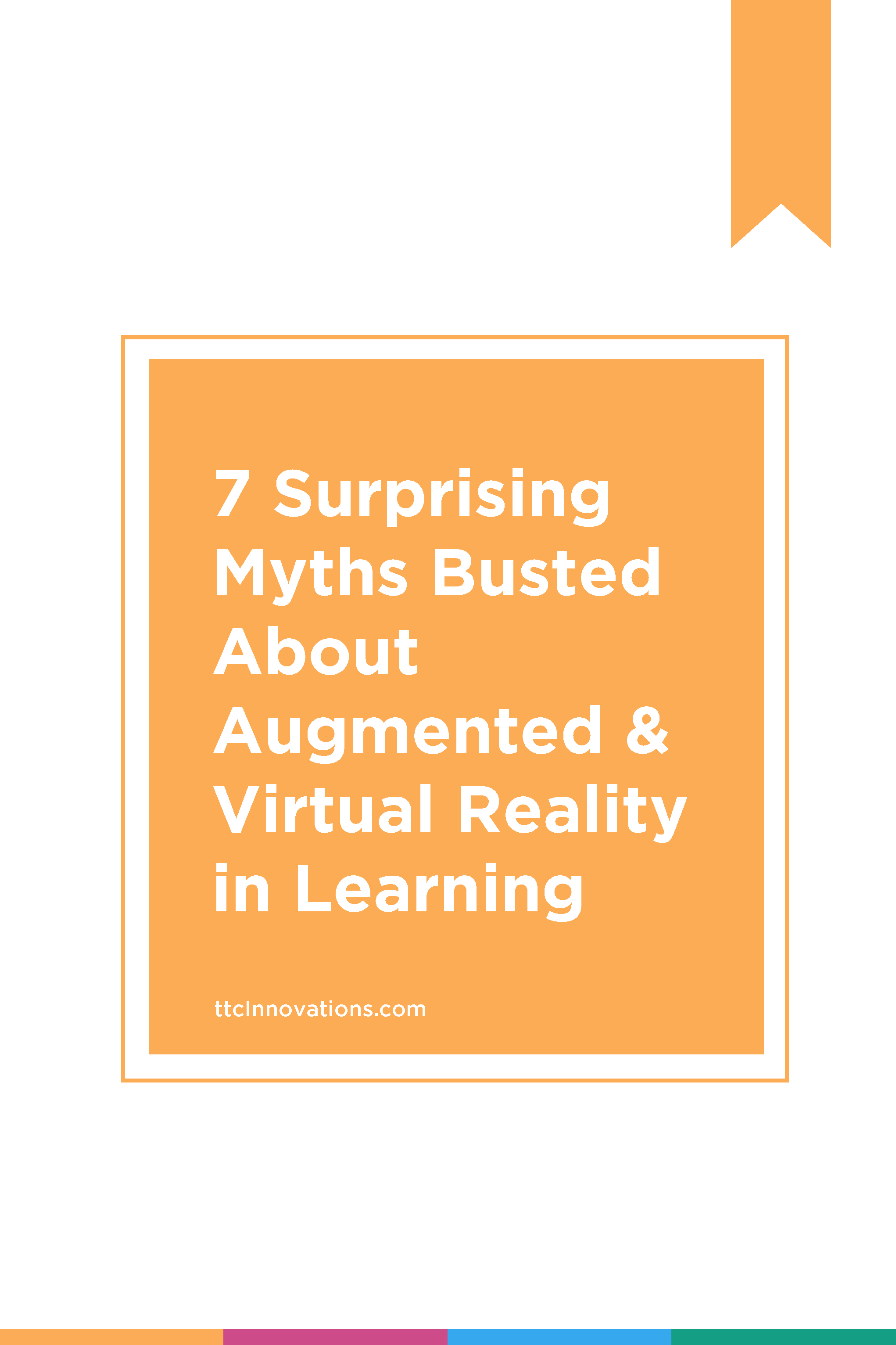Training with augmented and virtual reality is closer than you think. In fact, it’s here.
For many of us, phrases like “virtual reality” and “augmented reality” still seem like science fiction. If you’re a technophobe, VR and AR may even seem like some dystopian nightmare ready to erase our minds and place us all in a Matrix-like world where we can’t distinguish fantasy from reality.
I mean…maybe we’re in the matrix right now, right?
If you’re less conspiracy-minded and you specialize in employee training, your misgivings are probably much more practical. You likely just think it’s too expensive. Or unprofessional. Or that you could never create the content.
Wake up, corporate trainers! VR and AR are here. Employees love them, and most importantly — they work. VR and AR aren’t just fads; they’re legitimate learning trends that are here to stay.
If you’re confused about the terms, here’s a little clarification: Virtual reality (VR) creates a completely artificial environment for the user. You can put on a pair of VR glasses and climb Mount Everest or fend off an army of zombies, and it feels like you’re really there.
Augmented reality (AR), on the other hand, integrates digital elements within a user’s actual environment. Remember the Pokémon Go™ craze a few years back when we could see Pokémon characters standing in our front yards through our smartphones? That’s AR. And if you’re not a Pokémon fan (but who isn’t?), check out the yellow first-down line the next time you watch a football game. That’s right: AR.
So how do we use these futuristic technologies in employee training? Well, the possibilities are nearly endless. But first, we have to get past a few myths that can create barriers in embracing VR and AR.
Myth #1: AR and VR Are Too Expensive
Like any technology, the price of AR and VR has plummeted as they’ve become more widespread and mainstream. You can thank the gamers out there for keeping the prices down, and the technology is remarkably affordable for most organizations. According to Ramnik Singh from eLearning Industry, AR is 40-50% cheaper than gamification, and it “brings in a mixed life (virtual and real life) experience in contrast to gamification’s virtual experience.”
“AR is 40-50% cheaper than gamification” – @elearningindustry Share on X
Likewise, VR has become surprisingly affordable. Gone are the days when a VR headset could cost over $24,000! Amazon now lists headsets for as low as $9.99, with recommended models in the $25 range. That’s cheaper than buying a boxed lunch for an instructor-led training session!
Myth #2: AR and VR Will Make People More Isolated
Many people see AR and VR as enhanced versions of the family sitting down to dinner together, disconnected because everyone is on their phones. Won’t we just retreat into our little virtual worlds with little or no need for human interaction? Won’t our trainees distance themselves from coworkers in favor of a perfect virtual world?
In fact, AR and VR users generally don’t disengage from the real world. According to David Oh from electronicdesign.com –
“Rather than cutting them off from the real world, AR is designed to better integrate users with the real world. Augmented reality both complements and enriches the world. With the appropriate applications, AR supplies users with just the information they need—exactly when they need it.”
Remember seeing groups of youngsters frantically chasing down invisible Pokémon friends together? The Pokémon GoAR experience was anything but isolating.
VR has been known to create a similar bonding experience. Juanita Leatham, writing for vrfitnessinsider.com, relates –
“In January 2018, players in VR Chat were having fun chatting, trolling, and dancing, only to find that one of their fellow VR Chat members collapsed to the floor with a seizure. The whole room surrounded the man and was concerned for his well-being, checking in with him and making sure he was alright once the seizure subsided. If that’s not social we don’t know what is.”
Technology may keep our noses in our phones a bit too often, but we don’t lose our humanity.
Myth #3: AR and VR Are Just for Games and Entertainment
Applications like Pokémon Go brought AR to the public’s attention, but at a cost for professional developers; many people think it has no potential beyond gaming. In the same manner, most people imagine themselves fending off ninjas or exploring the Mariana Trench when they think of VR. It’s just for fun, right?
Oh sees a different future:
“Today, and for the next three to five years, the lion’s share of AR hardware and app software will focus on the business and professional environments, where it will facilitate communications, enhance collaboration—even half-way around the world—and foster creativity.”
And here’s the real kicker: AR and VR are still fun. It’s okay to have fun during training!
Myth #4: AR and VR Won’t Work in a Professional Environment
We know what you’re thinking: My office will become a bunch of Gen Z junior execs sitting around their cubicles wearing VR headsets and saying, “Cool!” a lot.
Related: 5 Unique Generation Z Characteristics & How to Train Them
Well, there might be a little oohing and aahing, because VR and AR are cool. But David Oh sees it not only as professional, but also transformative:
“Those who envision AR as involving a lot of hand-waving in the middle of a workplace environment have missed the point of AR. Because of its visual focus and ability to integrate computer images with the real world, workplace apps are designed to facilitate information transfer, enhance productivity, and facilitate one-on-one collaborative communications.
However, just as computers of a generation ago permitted a reorganization of the workspace, so too will AR encourage a reimagining of the workspace environment in ways that are just now being considered by pioneers in the AR/workspace integration field.”
AR and VR are not just professional; they have the power to change what we think of as professional. Share on X
Myth #5: AR and VR Require Too Much Special Equipment
Sci-fi buffs imagine full-body VR suits and elaborate headsets, but VR can be done much more simply. The most common VR headsets are designed so that a smartphone can slip inside, using the phone’s screen and sound to create a VR environment.
Likewise, AR can be done with common technology like smartphones and tablets. Pokémon Go worked with smartphones, and the most common AR tech today — the yellow first-down line in football games — works with just a TV.

One FREE Week!
New clients, tap into our talent with one week of Innovators on Demand® on us.
Get started with one of our skilled Innovators.
Myth #6: AR and VR Won’t Improve Learning
Because of their roots in gaming and their reputation as “the next big thing,” many trainers and educators see AR and VR as just another fad with little potential to actually improve learning. Practical applications, however, show the vast potential for learning with these new technologies.
A series of case studies were recently published that show the effectiveness of these new technologies. Among the highlights:
- Surgeons trained via VR to perform operations performed 29% faster and made 6 times fewer errors than those trained via conventional methods.
- Using an Intelligent Tutor System in a virtual simulation, soldiers had 2.7 times more successful missions than those who did not use the simulation tutor system.
- Soldiers who used game-based simulations made fewer errors in their aircrew activities. Further, those who took the game-based training voluntarily did additional practice.
These case studies are just the tip of the iceberg for the potential of AR and VR. New ideas and applications are being developed every day.
Myth #7: Content Is Too Hard to Create
AR and VR require a rethinking of how we do training. They also require some education in creating the content. But don’t panic — it’s not as hard as you think.
A variety of user-friendly AR and VR creation apps like Unity (there’s even a free version) have sprung up in the last few years, and there are many tutorials available on the web. This tutorial makes it feel like anyone (even I!) can create a VR app.
Even if you don’t want to take on the tech yourself, you can easily use staff augmentation like Innovators on DemandTM to bring on a VR or AR expert on a per-project basis. ttcInnovations can also bring an entire team to your (virtual) doorstep to help with the new tech!
You CAN Train with VR and AR!
AR and VR are now accessible to nearly anyone. As an employee trainer or training developer, the key is in thinking differently and working toward solutions that can utilize the latest learning trends and this powerful technology.
When you’re getting started with VR and AR:
- Choose your first projects carefully. What specific tasks can be best learned using this technology? Be sure you’re not using tech for tech’s sake. Our CEO, Debbie Wooldridge, writing for trainingindustry.com, recommends using VR if the actual experience falls into one of four categories: expensive, dangerous, impossible, or rare.
- Bring in expertise. Use staff augmentation if possible to get your feet wet and to help you learn about the possibilities, limitations, and how-tos of AR and VR.
So go for it! AR and VR are here to stay, and your employees and company can benefit from their enhanced potential for teaching and training. What’s stopping you?







